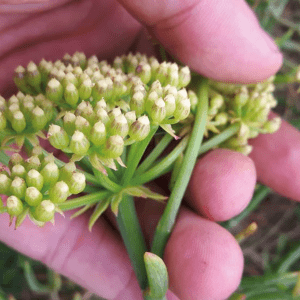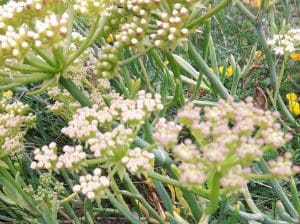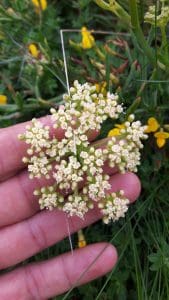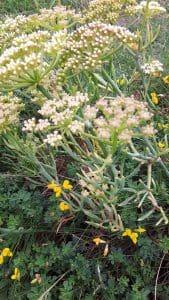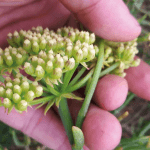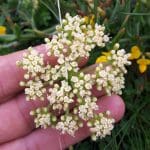Rock Samphire / Spring / Summer / Autumn / Edible
Common Names
Samphire, Stone Samphire, Rock Samphire, Sea Fennel
Botanical Name
Crithmum maritimum
Scientific Classification
Kingdom – Plantae
Order –Apiales
Family – Apiacea
Physical Characteristics for Rock Samphire
Rock Samphire is a fleshy perennial growing to 30cm tall and wide.
Leaves
The leaves grow off the short stalks and are pinnately branches with succulent lobes. They look a little like thick, green, succulent antlers.
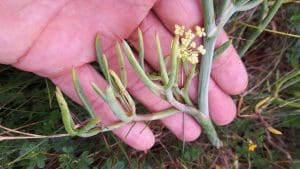
Flowers
The flowers are typically 2 mm in diameter, yellow to green and they grow in standard umbels roughly 4-6cm in diameter. They’re quite substantial in weight for their size.
Where the flowers connect to the stem, there is a set of leaves, that are a thinly spear shaped, coming out all around the stem.
Early in the year, skeletons of previous season’s flower heads usually persist.
Seeds
Everywhere there was a bud of flowers you will find a pod of seeds growing. Rugby ball shaped
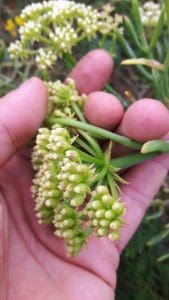
Habitat
Found in coastal areas of Europe, from the Mediterranean to the UK, it prefers to grow on rocky cliffs and rocky edges.
Known Hazards
None known
Could be Confused with
None, however, it is in the Umbellifer family so be sure to double-check identification.
Click here to read more about the Umbellifer/Carrot family.
Edible Uses
Rock Samphire has a truly bold flavour and a little goes a long way with this one. The flavour has been described, in it’s most crude, as somewhere between carrot tops and petrol, however I prefer to describe it as somewhere between carrots, parsnips and fennel.
If you want to eat a good volume of this, as a main or side dish, then boil it in 3 to 4 changes of water and add butter and lemon juice.
Or, in my opinion, it’s best to think of this plant as a strong flavouring herb, similar to dill & fennel. I love using it in potato salad or coleslaw or dicing it finely and stirring through oil to make a vinaigrette, it works really well as an accompaniment to fish – specifically mackerel.
Leaves: steamed, boiled, pickled, salted
Flower: raw for strong flavour
Seeds: best pickled or salted
Notes on Herbal uses
Diuretic, helping to aid digestion, said to help aid weight loss if eaten raw (possibly because the flavours are so pungent it may make you stop eating)
Extra notes from the Foragers
Be careful when picking this plant and make sure to keep an eye on your surroundings, it’s fairly easy to pick away before you realise there’s a 100ft drop right next to you.




